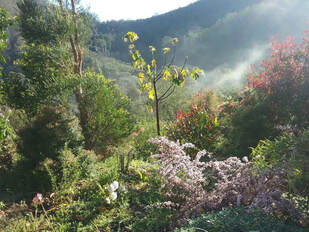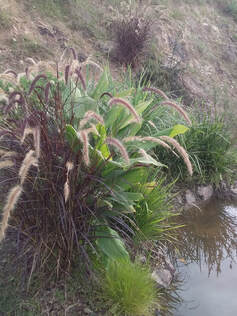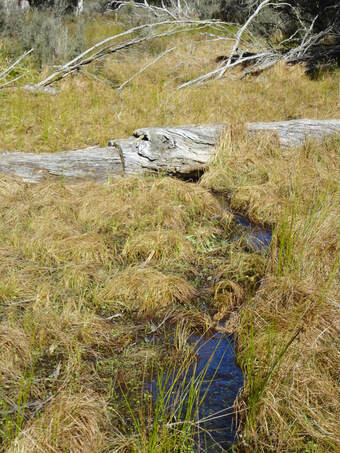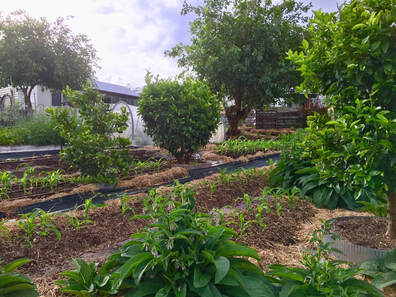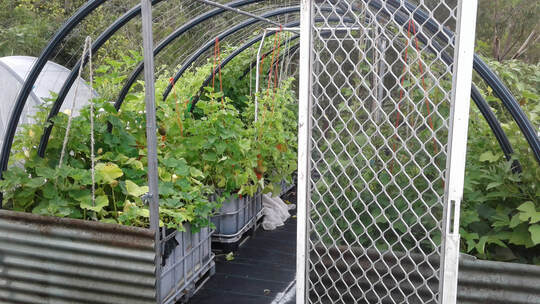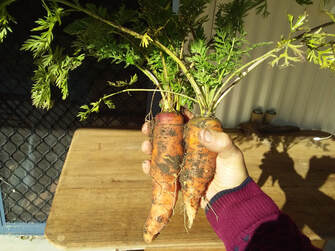|
A guide to our resources
For readers who want to dig a little deeper, Ron Woods is your guide to articles and other readings on topics of interest to growers at all stages of their journeys. Topics (latest on top): - Growing in a changing climate - Maintaining soil moisture and minimising water loss - From the soil up |
Growing in a changing climate
|
Thinking about success over the long term means preparing for challenges as they arise, and finding ways to adapt, innovate, and improve. One of these long term challenges is climate change.
|
As are many other people, growers are taking stock of the effects of shifting weather patterns between and within the seasons. Growers have the additional advantage of being able to witness first-hand the effects of climate change on the plants and animals they care for, and on the animals that visit. All of those who work with the soil work on finding solutions to problems such as rainfall variability, floods, severe winds, heatwaves, bushfires and invasive species.
Key to growing for the long term is the ability to bounce back after upsets, failures and disasters. This resilience is what keeps us going, both as individuals and as communities. Seeking information from a wide range of sources, learning through doing, and staying connected can all help us to build climate resilience.
Key to growing for the long term is the ability to bounce back after upsets, failures and disasters. This resilience is what keeps us going, both as individuals and as communities. Seeking information from a wide range of sources, learning through doing, and staying connected can all help us to build climate resilience.
The NSW Government Department of Environment and Heritage produced a series of climate change snapshots for regions of the state in 2014. Our region is included in the North Coast Region snapshot as the southernmost part of this broad region. Based on long-term (1910–2011) observations, temperatures have been increasing in the North Coast Region since about 1970, with higher temperatures experienced in recent decades. The warming is projected to continue.
Using the 1990–2009 period as a baseline for measurements, projections are made for changes to temperature, rainfall and fire weather. Highlighting the point that the warming trend is a process, projections are made for the near future (2020–2039), and for the far future (2060–2079).
Using the 1990–2009 period as a baseline for measurements, projections are made for changes to temperature, rainfall and fire weather. Highlighting the point that the warming trend is a process, projections are made for the near future (2020–2039), and for the far future (2060–2079).
Temperature: Average temperature is projected to increase by 0.7°C in the near future, and by 2°C in the far future. The number of hot days (above 35 degrees) will increase, and the number of cold nights (below 2 degrees) will decrease. Minimum temperatures are projected to increase in the near future by 0.5 – 1.0°C; and by 1.6 – 2.5°C in the far future.
Rainfall: Changes are associated especially with greater variability and changes in the extremes. Overall, rainfall is projected to decrease in winter and to increase in autumn and spring. Some models predict wetter, and others drier, scenarios for summer.
Fire: Based on classifications in the Forest Fire Danger Index (FFDI), 'Average' fire weather is projected to increase in summer and spring. 'Severe' fire weather days are projected to increase in summer and spring, but to decrease in autumn due to the projected increase in rainfall.
Rainfall: Changes are associated especially with greater variability and changes in the extremes. Overall, rainfall is projected to decrease in winter and to increase in autumn and spring. Some models predict wetter, and others drier, scenarios for summer.
Fire: Based on classifications in the Forest Fire Danger Index (FFDI), 'Average' fire weather is projected to increase in summer and spring. 'Severe' fire weather days are projected to increase in summer and spring, but to decrease in autumn due to the projected increase in rainfall.
Ron Woods dips into recent publications to explore some of the identified challenges for growers in light of climate change; to examine how others are understanding resilience from a grower's perspective; and, importantly, to discover what growers can do - and already are doing - to address the challenges of a changing climate. What are some of the key insights from this review of the national and international literature?
- Gardening in a changing climate is a definite topic of interest. The knowledge base is increasing. Many texts are freely available online.
- A consistent theme among the writers is the benefit of openness - being open to trying new things in the garden, to sharing frustrations and experiences with others, to knowing plants' limits, to allowing nature itself to guide you.
- In the face of increasing unpredictability, four key things to think about and focus on in a holistic way are temperature, rainfall, pollinators and bushfires. Growers may consider ways in which these interact to influence all aspects of growing - garden design, plant selection, soil, water, wind, biodiversity (including new invasive species), community, markets, etc... and adapt.
- Several researchers, writers and commentators discuss climate resilience. A useful approach is to see this not as something that is either there or not there, but rather as a quality that emerges when needed. Research is ongoing to help understand what the best conditions are for resilience to emerge.
Geoffrey Craggs, a researcher with the Northern Australia and Landcare Research program, provides a useful overview of water and its role in soil. In his paper ‘The role of water in ensuring healthy soils’, he writes that soil is made up of
Water enters soil from the top down through precipitation, and it is also drawn up from underlying deposits. It moves to occupy the tiny porous spaces between the mineral particles. In doing so, it binds the minerals together, transports the micro-organisms, and dissolves and also transports essential chemical nutrients such as nitrogen, potassium, phosphorus and carbon. Because water provides all of these services, it is important to have suffient and as consistent as possible levels of soil moisture.
- Minerals - clay, silt, gravel and sand in various combinations
- Organic matter derived from decaying plants and animals
- Live organisms, especially bacteria, fungi and earthworms
- Oxygen
Water enters soil from the top down through precipitation, and it is also drawn up from underlying deposits. It moves to occupy the tiny porous spaces between the mineral particles. In doing so, it binds the minerals together, transports the micro-organisms, and dissolves and also transports essential chemical nutrients such as nitrogen, potassium, phosphorus and carbon. Because water provides all of these services, it is important to have suffient and as consistent as possible levels of soil moisture.
|
Evaporation is a key way in which water gets ‘lost’ from the soil. The rate at which this occurs depends on factors such as humidity, cloudiness, air temperature, wind speed, and the vegetation present.
Evaporation also occurs through plants, which absorb liquid water through their roots, and give off water vapour through pores in their leaves. Rates of transpiration, as this form of evaporation is called, differ widely between different species of plants. Drainage is the other way in which water is lost. Just as water is essential for plants to survive, too much water can be harmful. Water-logging occurs when water does not flow into deeper soil layers due to poor internal drainage. |
Geoffrey makes the point that, in Australia, we need to consider hydrophobic or water repelling soils as an additional factor when it comes to maintaining soil moisture. Water repellence occurs when decomposing waxy materials from native plants coat soil particles, and this prevents water from infiltrating. This is a particular problem in poor sandy soils with less than five per cent clay, suggesting that one of the ways to tackle it involves the addition of more clay to your soil profile. Other means include adding organic matter, promoting bacteria that will break down the waxy material, creating furrows to trap water and prevent runoff, and planting species that are adapted to water repellent soils.
Bob Westerfiled in ‘Conserving water in the vegetable garden’ notes that vegetables like to have an ’even supply of water throughout the growing season’. ater use and conservation is important if you want to have a good crop. Ways to do this include:
- Use organic mulches, which reduce the fluctuations of soil moisture levels and have the added benefit of serving as a barrier to certain soil-borne diseases
- Irrigate in such a way that the plant foliage is kept dry. Do not, for example, stand in the garden and spray plants lightly every day. A thorough soaking is much more efficient. Also be careful of over-watering.
- Resist cultivating the soil, since this only increases moisture loss. If you need to reduce weed growth, try to leave the surface as smooth as possible.
- If you have the space and the funds for it, soaker hoses are very water efficient.They are particularly good at keeping root systems watered while leaving foliage dry.
Lin and colleagues ('Soil management is key to maintaining soil moisture in urban gardens facing changing climatic conditions') present evidence-based information in a ‘scientific report’ that may at first seem a bit daunting to read, but is well worth it if you persist.
Essentially, they are suggesting that four kinds of gardener management decisions are needed to achieve stable levels of soil moisture:
- Management of water and watering
- Crop management
- Soil management
- Ground cover management
In researching this, they found that the management factor that is most important is soil management. This includes focusing on the quality - and in particular the water holding capacity - of your soils. Recognise that water holding capacity is influenced by soil texture and porosity, as well as the presence of organic matter, all of which you have some control over. When all of these factors are well managed, a soil system results that has the structure and composition to maintain more water in the soil for longer periods of time. The gardener's management of the soil thus directly affects their management of water and watering, allowing for a less frequent watering schedule and the need for less water to be used in the first place. All of this contributes to the ideal for most plants - a level of soil moisture that does not fluctuate too widely.
Essentially, they are suggesting that four kinds of gardener management decisions are needed to achieve stable levels of soil moisture:
- Management of water and watering
- Crop management
- Soil management
- Ground cover management
In researching this, they found that the management factor that is most important is soil management. This includes focusing on the quality - and in particular the water holding capacity - of your soils. Recognise that water holding capacity is influenced by soil texture and porosity, as well as the presence of organic matter, all of which you have some control over. When all of these factors are well managed, a soil system results that has the structure and composition to maintain more water in the soil for longer periods of time. The gardener's management of the soil thus directly affects their management of water and watering, allowing for a less frequent watering schedule and the need for less water to be used in the first place. All of this contributes to the ideal for most plants - a level of soil moisture that does not fluctuate too widely.
Our northern neighbours in Port Macquarie-Hastings have produced ‘Water Efficient Gardening: Garden Book’, handbook that you could use at various points when you are considering watering and your garden. The writers note that ‘to be water efficient in your garden, you need to take some time to get to know your own environment’, so that you can work with what you have. Then you can apply the following underlying ‘water efficient gardening principles’:
- Good soil preparation, including adding organic matter regularly, a theme common to all of the texts
- Using plants suited to your particular local climate - for fruit, veggies and herbs find ways to make the best use of the micro-climates around your home and choose an area that is sheltered from prevailing hot, dry winds, and plant windbreaks where you can
- Keeping garden beds well mulched, another basic theme
- Introducing some shade into the garden, for example through having a high overhead framework covered with light shade cloth that an be removed in winter
- Being mindful of how and when you water
The series of pamphlets on ‘Soil biology basics’ may be a good place to start. This set of information sheets was produced by the New South Wales Department of Primary Industries in 2005. It has been a source of basic information for growers since then. The publisher itself notes that
…because of advances in knowledge, users are reminded of the need to ensure that information on which they rely is up to date, and to check the currency of the information with the appropriate officer of NSW Department of Primary Industries or the user’s independent adviser.
This is a valuable principle to keep in mind, not only when reading these texts, but any others as well. The Department’s website can be accessed at https://www.dpi.nsw.gov.au/
The topics in the ‘Soil biology basics’ series include:
Keeping with the theme of field trials, a text you may find interesting is the ‘Northern Rivers Soil Health Card’. This was developed by the Tuckombil Landcare Inc. in partnership with NSW Agriculture and the Natural Heritage Trust, and published in 2002. Although developed by farmers for farmers, the principles apply even if you have only a much smaller scale of land to work with. The basic principle is that ‘by testing regularly and keeping the cards, you can build up a record of your soil health, and understand the effect of management practices on soil health’.
The short article by Jim Barrow – ‘Understanding soils and nutrients Part 1 pH’ – focuses on a particular property of soil, namely pH. Published by The Society for Growing Australian Plants in 1999, Jim applies his discussion to his home area of Western Australia. While the soils in our region are likely to differ in key ways from those in coastal WA, he provides an interesting discussion of alkaline and acid soils, and also on what pH actually means. Our Network member Marnie Johnson has built on the material contained in the Jim Barrow article (Marnie’s pH notes) and applied them to her MidCoast hinterland soils. She helpfully includes a potting mix recipe.
From another of our Network members, Brett Cooper from Limestone Permaculture, we have two very interesting documents to share. The first one is on Dynamic Accumulators, and provides a short guide on deep-rooted plants that help to provide beneficial nutrients such as Iron, Potassium and Magnesium to your soil. Did you know that plants such as comfrey, dandelion, watercress, and (ouch) stinging nettle are very helpful in this regard?
Brett’s second text – ‘Sheet mulching 101 with Limestone Permaculture’ – links into the other important aspect of soil care that we address, namely composting, mulching and worm farming. These are the kinds of practical things you can be doing on a regular basis to build up and maintain soil health. This useful guide contains the minimum of text and the maximum of visuals, great photos that show step by step what you can be doing when preparing an area of your garden for the plants that you have in mind.
Every grower knows about the importance of composting and mulching (as well as worm farming), and there are many stories that you too could be sharing on these topics, we are sure of that! To provide some additional food for thought, our collection of resources includes hands-on guides on topics such as on ‘hot composting’; on mulching, including sowing ‘green manure’ crops; and on those valuable workers in the garden, namely worms. Did you know that earthworms typically live from four to eight years, while some can live up to ten years?
Finally, we return to the ‘Soil biology basics’ series with which this overview of resources started. There is a pamphlet from the NSW Department of Primary Industries on 'How to build organic matter in your soil'. This pamphlet provides a useful summary of techniques ranging from rotating crops and retaining crop residues, to reducing tillage and erosion and reducing periods of ‘bare fallow’. A basic principle seems to be – 'maximise the addition of new organic materials and minimise losses from the soil’.
We wish you much joy in your garden as you prepare for the warmer months. Check out our blogs, which also have a focus on soils, and you are welcome to share your stories with us ([email protected]).
…because of advances in knowledge, users are reminded of the need to ensure that information on which they rely is up to date, and to check the currency of the information with the appropriate officer of NSW Department of Primary Industries or the user’s independent adviser.
This is a valuable principle to keep in mind, not only when reading these texts, but any others as well. The Department’s website can be accessed at https://www.dpi.nsw.gov.au/
The topics in the ‘Soil biology basics’ series include:
- 'Microbes and minerals', which provides an overview of nutrients in the soil.
- 'How to encourage soil organisms', which all play an essential role in the decomposition of organic matter, and in the cycling of nutrients, thus fertilising the soil.
- 'Soil bacteria', amongst which are decomposers, nitrogen fixers, and disease suppressors.
- 'The rhizosphere', which is an area of intense biological and chemical activity in the zone of soil surrounding a plant root.
- 'Nematodes', most of which have a beneficial role in the soil, but which can also become pests due to their impact on agricultural production.
- 'Questions to ask about soil biology products', in light of the numbers of brand names and novel products on the market.
- 'How to conduct your own field trials' to see whether a product makes a difference to your soil.
Keeping with the theme of field trials, a text you may find interesting is the ‘Northern Rivers Soil Health Card’. This was developed by the Tuckombil Landcare Inc. in partnership with NSW Agriculture and the Natural Heritage Trust, and published in 2002. Although developed by farmers for farmers, the principles apply even if you have only a much smaller scale of land to work with. The basic principle is that ‘by testing regularly and keeping the cards, you can build up a record of your soil health, and understand the effect of management practices on soil health’.
The short article by Jim Barrow – ‘Understanding soils and nutrients Part 1 pH’ – focuses on a particular property of soil, namely pH. Published by The Society for Growing Australian Plants in 1999, Jim applies his discussion to his home area of Western Australia. While the soils in our region are likely to differ in key ways from those in coastal WA, he provides an interesting discussion of alkaline and acid soils, and also on what pH actually means. Our Network member Marnie Johnson has built on the material contained in the Jim Barrow article (Marnie’s pH notes) and applied them to her MidCoast hinterland soils. She helpfully includes a potting mix recipe.
From another of our Network members, Brett Cooper from Limestone Permaculture, we have two very interesting documents to share. The first one is on Dynamic Accumulators, and provides a short guide on deep-rooted plants that help to provide beneficial nutrients such as Iron, Potassium and Magnesium to your soil. Did you know that plants such as comfrey, dandelion, watercress, and (ouch) stinging nettle are very helpful in this regard?
Brett’s second text – ‘Sheet mulching 101 with Limestone Permaculture’ – links into the other important aspect of soil care that we address, namely composting, mulching and worm farming. These are the kinds of practical things you can be doing on a regular basis to build up and maintain soil health. This useful guide contains the minimum of text and the maximum of visuals, great photos that show step by step what you can be doing when preparing an area of your garden for the plants that you have in mind.
Every grower knows about the importance of composting and mulching (as well as worm farming), and there are many stories that you too could be sharing on these topics, we are sure of that! To provide some additional food for thought, our collection of resources includes hands-on guides on topics such as on ‘hot composting’; on mulching, including sowing ‘green manure’ crops; and on those valuable workers in the garden, namely worms. Did you know that earthworms typically live from four to eight years, while some can live up to ten years?
Finally, we return to the ‘Soil biology basics’ series with which this overview of resources started. There is a pamphlet from the NSW Department of Primary Industries on 'How to build organic matter in your soil'. This pamphlet provides a useful summary of techniques ranging from rotating crops and retaining crop residues, to reducing tillage and erosion and reducing periods of ‘bare fallow’. A basic principle seems to be – 'maximise the addition of new organic materials and minimise losses from the soil’.
We wish you much joy in your garden as you prepare for the warmer months. Check out our blogs, which also have a focus on soils, and you are welcome to share your stories with us ([email protected]).



